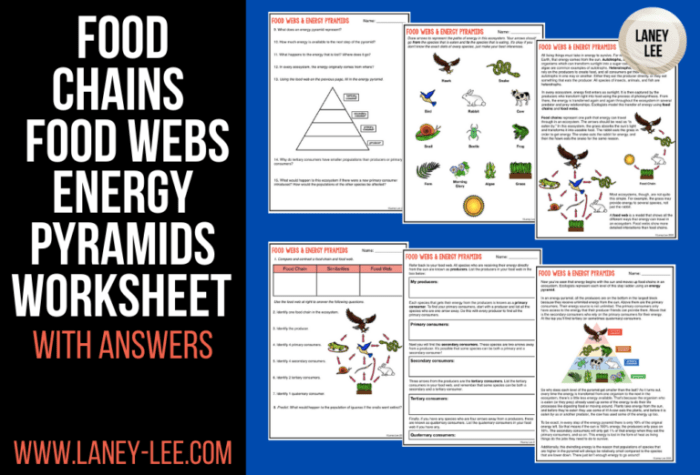Food chains and food webs worksheet answers – Embark on a captivating journey into the realm of food chains and food webs with our comprehensive worksheet answers. This guide delves into the intricacies of ecological relationships, empowering you with a profound understanding of these fundamental concepts.
Within this meticulously crafted document, you will unravel the essential components of food chains and food webs, exploring their significance in maintaining the delicate balance of ecosystems.
Food Chains and Food Webs Overview
Food chains and food webs are fundamental concepts in ecology, describing the interconnected feeding relationships among organisms within an ecosystem. A food chain represents a linear sequence of organisms, where each organism consumes the one below it in the chain, ultimately transferring energy from producers to top predators.
Food webs, on the other hand, are more complex and interconnected, representing the multiple feeding relationships that occur within a community of organisms. They depict the intricate network of who eats whom, providing a comprehensive view of the ecosystem’s trophic dynamics.
Importance of Food Chains and Food Webs in Ecosystems
- Energy flow: Food chains and food webs facilitate the transfer of energy from producers (e.g., plants) through consumers (e.g., herbivores, carnivores) to decomposers (e.g., bacteria, fungi).
- Nutrient cycling: The consumption and decomposition of organisms within food chains and food webs contribute to the recycling of nutrients back into the ecosystem, ensuring their availability for primary producers.
- Ecosystem stability: Food chains and food webs provide stability to ecosystems by regulating population sizes and maintaining a balance among different species.
Components of Food Chains and Food Webs

Trophic Levels, Food chains and food webs worksheet answers
- Producers: Organisms that can synthesize their own food from inorganic matter (e.g., plants, algae).
- Consumers: Organisms that obtain energy by consuming other organisms (e.g., herbivores, carnivores, omnivores).
- Decomposers: Organisms that break down dead organisms and organic matter, releasing nutrients back into the ecosystem (e.g., bacteria, fungi).
Flow of Energy and Nutrients
Energy flows through food chains and food webs in a unidirectional manner, from producers to consumers to decomposers. At each trophic level, a significant portion of the energy is lost as heat, resulting in a decrease in energy availability at higher trophic levels.
Nutrients, on the other hand, are recycled within food chains and food webs through the consumption and decomposition of organisms. Decomposers play a crucial role in releasing nutrients back into the ecosystem, making them available for primary producers.
Types of Food Chains and Food Webs

Food Chains
- Linear food chains: Simple chains with a single pathway of energy flow (e.g., grass → grasshopper → frog → snake).
- Branched food chains: Chains with multiple pathways of energy flow, resulting in a more complex structure (e.g., grass → grasshopper → frog; grass → grasshopper → bird).
Food Webs
Food webs are interconnected networks of multiple food chains, depicting the complex feeding relationships within an ecosystem. They provide a comprehensive understanding of the trophic dynamics and energy flow patterns.
Complexity and Interconnectedness
Food webs vary in complexity, ranging from simple systems with a few species to highly complex networks with hundreds of species. The interconnectedness of food webs ensures ecosystem stability and resilience, as disruptions to one species can have cascading effects on others.
Factors Influencing Food Chains and Food Webs

Abiotic Factors
- Climate: Temperature, precipitation, and sunlight can influence the distribution and abundance of organisms, affecting food chain and food web dynamics.
- Habitat structure: The physical structure of an ecosystem (e.g., forest, grassland) can influence the types of organisms present and their interactions.
Biotic Factors
- Competition: Competition for resources (e.g., food, habitat) can influence the abundance and distribution of organisms within food chains and food webs.
- Predation: Predators can regulate the populations of prey species, shaping the structure and dynamics of food chains and food webs.
- Mutualism: Symbiotic relationships between different species can influence the survival and success of both partners, impacting the overall food web structure.
Human Activities
Human activities can significantly alter food chains and food webs. Habitat destruction, pollution, and overexploitation of resources can disrupt ecosystem balance and lead to species extinctions.
Applications of Food Chains and Food Webs
Ecological Studies
- Understanding ecosystem structure and dynamics.
- Investigating energy flow and nutrient cycling.
- Predicting the impacts of environmental changes.
Ecosystem Management and Conservation
- Identifying keystone species and their roles in maintaining ecosystem balance.
- Developing conservation strategies to protect vulnerable species and their habitats.
- Managing invasive species and their impacts on native ecosystems.
Human Societies
Understanding food chains and food webs has implications for human societies, such as:
- Sustainable agriculture and food production.
- Conservation of biodiversity and ecosystem services.
- Assessing the impacts of human activities on ecosystems.
Key Questions Answered: Food Chains And Food Webs Worksheet Answers
What is the difference between a food chain and a food web?
A food chain is a linear sequence of organisms through which energy flows, while a food web is a complex network of interconnected food chains.
What are the different trophic levels in a food chain?
Producers, consumers, and decomposers are the three main trophic levels in a food chain.
How do food chains and food webs influence ecosystem stability?
Food chains and food webs play a crucial role in maintaining ecosystem stability by regulating population sizes and nutrient cycling.